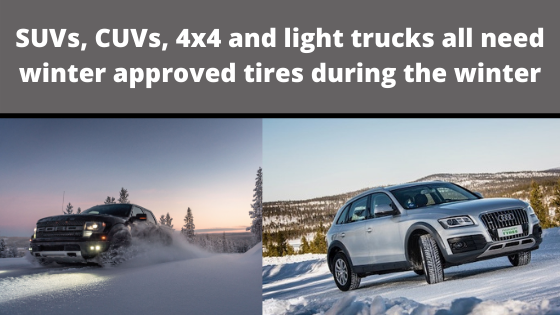When the winter arrives, we need to adjust our car tires to winter approved ones. The only tires that are approved for winter use are the dedicated winter tires that should be combined with all-season tires, and certain winter approved all-weather tires. Winter tires should always be mounted before the first snow arrives. All-season tires aren’t approved for winter use as they aren’t equipped with the right tools for combating winter conditions. They have a tread that is geared towards dry or wet roads and not snow, ice and snow. The compound is also not optimized for low temperatures, so the tires will turn hard. Hard tires can’t deliver the same traction and grip as soft tires, this is why you need to change before they turn hard. They tend to turn hard around 45 degrees Fahrenheit.
You have the option to settle for one set of tires for the whole year by choosing al-weather tires instead of alternating between all-season tires and winter tires. If you choose only one set of tires, it can be more convenient, as you always have tires that are appropriate for the weather conditions. You will then only have one set of tires and you won’t have to have a second set that you will need to store during the year. When you have two set of tires, the actual wear on each set will be lower as they are only used during part of the year.
When you are only using one set of tires for the whole year it is important that you will rotate the position of the tires so that you can even out the difference that you have in wear between tires on the front and rear axle. You should make the rotation when you notice a difference of more than 5/64 inches. This will even out the wear and make it possible to change all the four tires to new ones, once you have worn out the tires. You should change to new tires when they reach a tread depth of 5/32 inches. This is more important for winter tires as they require more depth to handle snow and slush.
By changing all four tires at the same time, you will not alter the performance of the car, which can happen if you have different grip on different positions of the car. This can cause the car to over- or understeer based on that you lose grip on certain tires. You should also always have the same type of tires on all positions, so never mix tires in a way that you have winter tires combined with all-season tires. This will make the car difficult to drive and will not improve the safety of the car to the levels that you need during winter conditions. So make sure to change all four tires, rotate them and make sure that you have winter tires on your car before the winter arrives.
For more information regarding winter tires to complement your all-season tires during the winter season, visit: www.nokiantires.com
